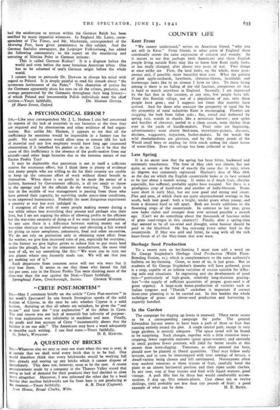Late Spring It is no secret now that the spring
has been bitter, backward and extremely treacherous. The frost of May 16th was almost, but not quite, as severe as the frost of exactly the same day in 1935, when 20 degrees was commonly registered. Hudson's date of May 18th as the day on which the English countryside looks at its best seemed to be just about a month wrong. It seems as if much fruit, cherries especially, has suffered; probably apples have escaped. Yet there is a prodigious crop of hazel-nuts and another of holly-blossom. Beans were short in early May, but are now good and strong and sweet. Flax and peas, of which there are quite unprecedented sowings in the south, both look good: both a bright, tender green when young, and from a distance hard to tell apart. Both are lovely additions to the flowering crops of the countryside. In contrast to last year, grass now looks richer and stronger than ever seemed possible a month ago. (Can't we do something about the thousands of luscious miles of grass road-verges in this country?) Finally, after a spring-time that seemed to be all ice-wind and drought, some honour should be paid to the blackbird. He has otr-sung every other bird in the countryside. If May was arid and bitter, he sang with all the rich heart-break of an the May-times that ever were.


























 Previous page
Previous page